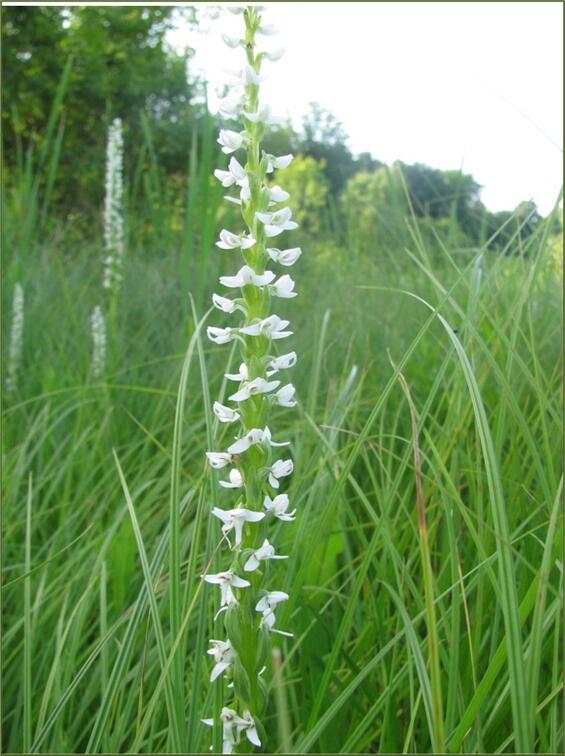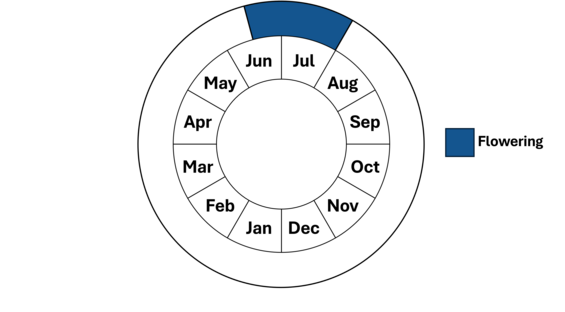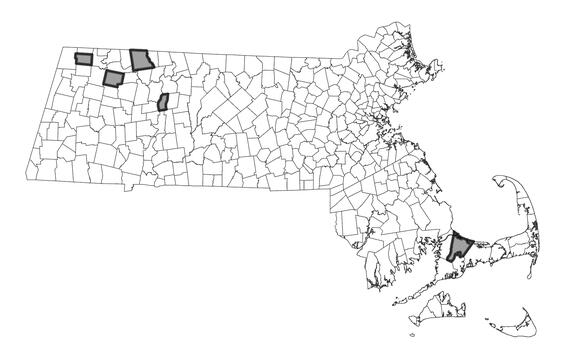- Scientific name: Platanthera dilatata
- Species of Greatest Conservation Need (MA State Wildlife Action Plan)
- Threatened (MA Endangered Species Act)
Description
Leafy white orchid, or bog candles, is a tall, leafy-stemmed, stout or slender perennial in the orchid family (Orchidaceae) that rises from fleshy roots and ends in a slender spike of white flowers. It is erect, hairless, and reaches up to 1 m (3 ft) in height. The lanceolate leaves number about twelve and become progressively smaller toward the top of the plant. Leafy white orchid’s small flowers are generally bright white and are arranged in a 1-3 dm (0.33-1 ft) long spike. Their delightful fragrance has been likened to cloves. The 5-10 mm (0.2-0.4 in) long lip, or lowermost petal, widens near the base and has five to seven prominent veins. The spur (a hollow extension of the flower) is about as long as the lip. Leafy white orchid’s fruit is a 12 x 6 mm (0.47 x 0.24 in) ellipsoid capsule (a fruit that is formed from a compound pistil and that contains many seeds).
The white-fringed orchid (Platanthera blephariglottis) and the clubspur orchid (Platanthera clavellata), two white to whitish-flowered orchids of somewhat similar habitats, could be confused with leafy white orchid. However, in our area, the lip of white-fringed orchid is deeply fringed. The clubspur orchid is both shorter, 1-4 dm (0.33-1.33 ft), than the leafy white orchid and, generally, has only one well-developed leaf on its stem.

Life cycle and behavior
Like all our native orchids, leafy white orchid is reliant on mycorrhizae fungi to initiate growth of its seeds and young plants. It is likely that it maintains the same fungal relationship throughout its life. This is a perennial species. In Massachusetts, the plant blooms from mid-June through July. Each capsule will release thousands of small seeds to be wind dispersed. The flowers are fragrant with a sweet spicy scent. It is thought that these plants are pollinated by skippers.

Population status
Leafy white orchid is currently listed as threatened in Massachusetts. There are six populations verified since 1999 in Barnstable, Berkshire and Franklin Counties. Previously, it also occurred in Middlesex County.
Distribution and abundance
The North American range of leafy white orchid has been documented as extending across Labrador to Alaska and south to New Jersey, Wisconsin, South Dakota, New Mexico, and California. Leafy white orchid is also considered rare in Illinois, Indiana, New Mexico, Pennsylvania, and Wisconsin. In New England, leafy white orchid is imperiled in Massachusetts, possibly extirpated in Connecticut, apparently secure in Vermont, and not ranked in Maine and New Hampshire. It is not known from Rhode Island.

Distribution in Massachusetts.1999-2024. Based on records in the Natural Heritage Database
Habitat
Leafy white orchid is a plant of sunny, wet areas, including bogs, seepage slopes and wet woods, especially where cold water surfaces to form springs. It prefers non-acid soil conditions. In Massachusetts, habitats include a cold, muddy, and springy seep; a springy wet spot near a road; an area of sphagnum and rich muck, with springs and streamlets; a wet, sedgy open area; and an open, springy seep adjacent to a tributary. Plant species associated with leafy white orchid include sphagnum moss (Sphagnum spp.), various horsetails (Equisetum spp.), willows (Salix spp.), alders (Alnus spp.), marsh fern (Thelypteris palustris), royal fern (Osmunda regalis), and yellow sedge (Carex flava).
Healthy habitats are vital for supporting native wildlife and plants. Explore habitats and learn about conservation and restoration in Massachusetts.
Threats
Reasons for the plant's rarity in Massachusetts include loss of habitat, due both to development and forest succession, and scarcity of suitable habitat. Warming of the climate, extended periods of drought also likely impact this species negatively. Changes in hydrology will also negatively impact the population. Deer browse may also be an issue. Small pops (less than 10 individuals) would have trouble recovering from disturbance or browse and may possess limited genetic variation/flexibility in the face of change.
Conservation
Survey and monitoring
Surveys for leafy white orchid are needed on a 5-to-10-year cycle, so that changes in the habitat can be assessed and mitigated if possible. As much as possible, surveys should be completed from the edges of the habitat, as these are fragile plants, and susceptible to trampling damage. The best time to survey for this species is when it is in bloom during late June or early July.
Management
As with many rare species, the exact management needs of leafy white orchid are not known. Invasive species should be controlled before they have a chance to enter the habitat of this species if possible. Management might also include opening the canopy by cutting selective trees on the edges of the habitat to allow more light in the area. To avoid inadvertent harm to rare plants, all active management of rare plant populations (including invasive species removal) should be planned in consultation with MassWildlife’s Natural Heritage & Endangered Species Program.
Research needs
Research is needed into the mycorrhizal fungi that are associated with leafy white orchid in Massachusetts. Is the mycorrhizal fungi one that associates with other growing plants, and if so, which ones, or is it a species that thrives on decaying material? It is important to understand the viability of the long-term seed of this species, especially in submerged environments.
References
Brown, P.M. Wild Orchids of the Northeast. 1997. Cornell University Press. Ithaca, N.Y. leafy white orchid grows.
Flora of North America Editorial Committee, 2002. Flora of North America Volume 26. Magnoliophyta: Liliidae: Liliales and Orchidales. Oxford University Press.
NatureServe. 2025. NatureServe Network Biodiversity Location Data accessed through NatureServe Explorer [web application]. NatureServe, Arlington, Virginia. Available https://explorer.natureserve.org/. Accessed: 5/1/2025.
POWO (2025). Plants of the World Online. Facilitated by the Royal Botanic Gardens, Kew. Published on the Internet; https://powo.science.kew.org/ Accessed: 5/1/2025.
Reddoch and Reddoch. 1997. The orchids in the Ottowa district. The Canadian Field Naturalist. Vol. 111p p. 112-113.
Smith, Welby R. 2012. Native Orchids of Minnesota. University of Minnesota Press, Minneapolis MN.
Sorrie, B.A. 1987. Notes on the rare flora of Massachusetts. Rhodora 89: 113-196.
Staudinger, M.D., A.V. Karmalkar, K. Terwilliger, K. Burgio, A. Lubeck, H. Higgins, T. Rice, T.L. Morelli, A. D'Amato. 2024. A regional synthesis of climate data to inform the 2025 State Wildlife Action Plans in the Northeast U.S. DOI Northeast Climate Adaptation Science Center Cooperator Report. 406 p. https://doi.org/10.21429/t352-9q86
Contact
| Date published: | May 2, 2025 |
|---|